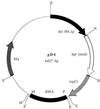Isolation and use of a homologous histone H4 promoter and a ribosomal DNA region in a transformation vector for the oil-producing fungus Mortierella alpina
- PMID: 11055907
- PMCID: PMC92363
- DOI: 10.1128/AEM.66.11.4655-4661.2000
Isolation and use of a homologous histone H4 promoter and a ribosomal DNA region in a transformation vector for the oil-producing fungus Mortierella alpina
Abstract
Mortierella alpina was transformed successfully to hygromycin B resistance by using a homologous histone H4 promoter to drive gene expression and a homologous ribosomal DNA region to promote chromosomal integration. This is the first description of transformation in this commercially important oleaginous organism. Two pairs of histone H3 and H4 genes were isolated from this fungus. Each pair consisted of one histone H3 gene and one histone H4 gene, transcribed divergently from an intergenic promoter region. The pairs of encoded histone H3 or H4 proteins were identical in amino acid sequence. At the DNA level, each histone H3 or H4 open reading frame showed 97 to 99% identity to its counterpart but the noncoding regions had little sequence identity. Unlike the histone genes from other filamentous fungi, all four M. alpina genes lacked introns. During normal vegetative growth, transcripts from the two histone H4 genes were produced at approximately the same level, indicating that either histone H4 promoter could be used in transformation vectors. The generation of stable, hygromycin B-resistant transformants required the incorporation of a homologous ribosomal DNA region into the transformation vector to promote chromosomal integration.
Figures







Similar articles
-
Establishment of an overall transformation system for an oil-producing filamentous fungus, Mortierella alpina 1S-4.Appl Microbiol Biotechnol. 2004 Sep;65(4):419-25. doi: 10.1007/s00253-004-1622-6. Epub 2004 May 12. Appl Microbiol Biotechnol. 2004. PMID: 15138730
-
Disruption of the fatty acid Delta6-desaturase gene in the oil-producing fungus Mortierella isabellina by homologous recombination.Curr Microbiol. 2007 Aug;55(2):128-34. doi: 10.1007/s00284-006-0641-1. Epub 2007 Jul 4. Curr Microbiol. 2007. PMID: 17619102
-
Selection and characterization of promoters based on genomic approach for the molecular breeding of oleaginous fungus Mortierella alpina 1S-4.Curr Genet. 2014 Aug;60(3):183-91. doi: 10.1007/s00294-014-0423-4. Epub 2014 Feb 22. Curr Genet. 2014. PMID: 24562865
-
Metabolic engineering for the production of polyunsaturated fatty acids by oleaginous fungus Mortierella alpina 1S-4.J Biosci Bioeng. 2013 Oct;116(4):417-22. doi: 10.1016/j.jbiosc.2013.04.008. Epub 2013 May 3. J Biosci Bioeng. 2013. PMID: 23648102 Review.
-
Advances in the production of various polyunsaturated fatty acids through Oleaginous Fungus Mortierella alpina breeding.Biosci Biotechnol Biochem. 2010;74(5):908-17. doi: 10.1271/bbb.100001. Epub 2010 May 7. Biosci Biotechnol Biochem. 2010. PMID: 20460719 Review.
Cited by
-
Focus and Insights into the Synthetic Biology-Mediated Chassis of Economically Important Fungi for the Production of High-Value Metabolites.Microorganisms. 2023 Apr 27;11(5):1141. doi: 10.3390/microorganisms11051141. Microorganisms. 2023. PMID: 37317115 Free PMC article. Review.
-
Versatile transformation system that is applicable to both multiple transgene expression and gene targeting for Thraustochytrids.Appl Environ Microbiol. 2012 May;78(9):3193-202. doi: 10.1128/AEM.07129-11. Epub 2012 Feb 17. Appl Environ Microbiol. 2012. PMID: 22344656 Free PMC article.
-
Characterisation of the Mucor circinelloides regulated promoter gpd1P.Curr Genet. 2004 Apr;45(4):225-34. doi: 10.1007/s00294-003-0484-2. Epub 2004 Jan 20. Curr Genet. 2004. PMID: 14735314
-
Molecular evidence that the rate-limiting step for the biosynthesis of arachidonic acid in Mortierella alpina is at the level of an elongase.Lipids. 2005 Jan;40(1):25-30. doi: 10.1007/s11745-005-1356-6. Lipids. 2005. PMID: 15825827
-
Transformation of an oleaginous zygomycete Mortierella alpina 1S-4 with the carboxin resistance gene conferred by mutation of the iron-sulfur subunit of succinate dehydrogenase.Curr Genet. 2009 Jun;55(3):349-56. doi: 10.1007/s00294-009-0250-1. Epub 2009 May 23. Curr Genet. 2009. PMID: 19466416
References
-
- Arnau J, Strøman P. Gene replacement and ectopic integration in the zygomycete Mucor circinelloides. Curr Genet. 1993;23:542–546. - PubMed
-
- Benito E P, Díaz-Mínguez J M, Iturriaga E A, Campuzano V, Eslava A P. Cloning and sequence analysis of the Mucor circinelloides pyrG gene encoding orotidine-5′-monophosphate decarboxylase: use of pyrG for homologous transformation. Gene. 1992;116:59–67. - PubMed
-
- Bilgin M, Dedeoglu D, Omirulleh S, Peres A, Engler G, Inzé D, Dudits D, Fehér A. Meristem, cell division and S phase-dependent activity of wheat histone H4 promoter in transgenic maize plants. Plant Sci. 1999;143:35–44.
-
- Burmester A. Analysis of the gene for the elongation factor 1α from the zygomycete Absidia glauca. Use of the promoter region for constructions of transformation vectors. Microbiol Res. 1995;150:63–70. - PubMed
-
- Burmester A, Wöstemeyer A, Wöstemeyer J. Integrative transformation of a zygomycete, Absidia glauca, with vectors containing repetitive DNA. Curr Genet. 1990;17:155–161.
Publication types
MeSH terms
Substances
Associated data
- Actions
- Actions
- Actions
- Actions
LinkOut - more resources
Full Text Sources
Other Literature Sources
Molecular Biology Databases

